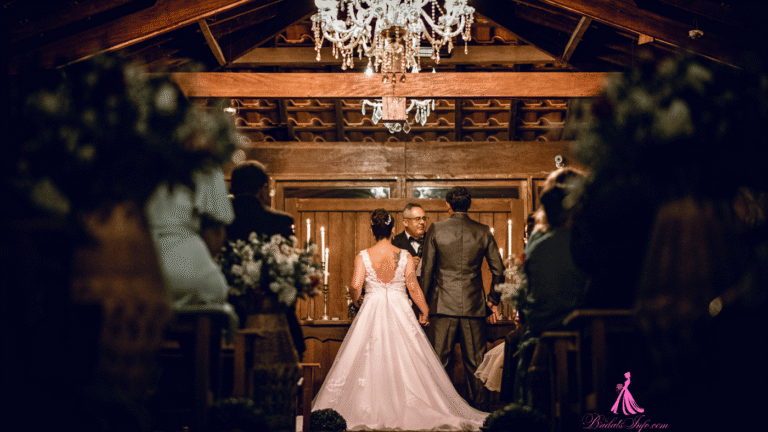It takes extra consideration to plan a Catholic wedding with guests from different cultural backgrounds, especially when the Mass is the focal point of the festivities. More couples are creating bilingual Catholic wedding Mass programs in the last ten years as a show of love that goes beyond language, rather than merely as a formality.
Carla and Miguel, one such couple, described how their bilingual program turned into a priceless memento for both families. Carla remembered, “When my grandmother saw the Lord’s Prayer translated into Spanish, she started crying.” “She felt included in every word, even though she didn’t understand English.” Stories like theirs are becoming remarkably prevalent in contemporary weddings, particularly in multicultural communities in Florida, Texas, and California, where bilingual Masses have significantly increased the ceremonies’ inclusivity.
Bilingual Catholic Wedding Mass Program Elements
(Simple format – easy to copy into WordPress)
| Section | English Label | Spanish Label | Purpose |
|---|---|---|---|
| Welcome Message | Welcome to the Wedding of… | Bienvenidos a la Boda de… | Sets the tone and greets all guests warmly |
| Introduction of Couple | Bride & Groom Names | Novia y Novio | Establishes the identity of the couple being united |
| Order of the Mass | Order of the Celebration | Orden de la Celebración | Provides a roadmap for the liturgy |
| Readings | First & Second Readings, Gospel | Primera y Segunda Lectura, Evangelio | Lists scripture and reader names |
| Prayers and Responses | Lord’s Prayer, Gloria, Sanctus | Padre Nuestro, Gloria, Santo | Encourages bilingual participation |
| Exchange of Vows | Vows and Rings Exchange | Intercambio de Votos y Anillos | Highlights the sacramental core of the ceremony |
| Wedding Party Details | Maid of Honor, Best Man, etc. | Dama de Honor, Padrino, etc. | Introduces the bridal party in both languages |
| Communion Guidelines | Communion Instructions | Instrucciones para la Comunión | Clarifies etiquette for Catholic and non-Catholic guests |
| Dedications and Memorials | In Memory / With Love | En Memoria / Con Amor | Honors loved ones, past and present |
| Thank You Note | Thank You for Sharing This Day | Gracias por Compartir Este Día | Offers gratitude and heartfelt closure |
These programs guarantee that guests actively—rather than passively—participate in one of the most significant occasions in a couple’s life by seamlessly integrating two languages. However, creating one involves more than just translating paragraphs. The goal is to create a structure that feels natural, respects both linguistic traditions, and maintains the liturgical rhythm.
Think visually first. English and Spanish can be displayed side by side in a dual-column format, which is especially effective. This arrangement is very obvious, particularly for visitors who might not be familiar with the Catholic Mass’s format. As an alternative, some couples switch between languages by section, which, when done well, adds a poetic cadence.
A welcome and introduction usually kick off the program’s structure. A kind introduction can be provided by including a brief bilingual note like, “We are so grateful to celebrate this sacred day with you.” Next, list the elements of the Mass: the Liturgy of the Word, the Prelude, the Processional, and the Opening Prayer. The Spanish translation of each component should be included as an equal partner, not as an afterthought. For instance, without assuming that one language is dominant, “Homily / Homilía” and “Gospel Reading / Lectura del Evangelio” appear one after the other.
It can be quite powerful to include congregational responses in both languages, such as “Amen” and “Thanks be to God.” Having the response cues printed in both languages encourages every guest to participate with confidence, even if the priest primarily leads the Mass in one language.
Even if the priest speaks only one language, be sure to provide a brief translation for the vows and the ring blessing. The occasion is highly symbolic, and visitors from both sides should be able to see its full significance. This is particularly poignant for bilingual couples, and it becomes a generational moment, even for grandparents who don’t speak the other’s language.
Music choices should also not be disregarded. Provide a list of hymns and choral works in both languages, or indicate whether the song’s verses will change. Despite its modesty, this degree of attention fosters a spiritual environment that is remarkably inclusive. Consider the classic song “Ave María,” which is frequently sung in Spanish or Latin. Just as Spanish-speaking relatives feel inspired when they hear sacred music in their native tongue, English-speaking guests value knowing when and why it’s being sung.
Some couples have embraced the particularly creative addition of providing succinct explanations of the program’s liturgical moments. For example: “The Eucharist, which symbolizes the body and blood of Christ, is a central act of Catholic worship.” Spanish translation: “The Eucaristía is a central act of Catholicism that symbolizes the body and blood of Christ.” In addition to being instructive, these notes give visitors a sense of familiarity in an otherwise unfamiliar environment.
Think about design decisions that honor your common heritage in addition to structure. Even a simple template can seem opulent when printed on high-quality cardstock with delicate accents, even though celebrity weddings like Salma Hayek’s and Eva Longoria’s have featured elaborate calligraphy and specially designed paper. A small crucifix, a delicate Marian symbol, or a soft gold border can visually connect the program to a church’s hallowed setting.
Including a section that introduces the wedding party is also very helpful. This is about connection, not just naming names. Families on both sides can better understand each person’s role and relationship to the couple by listing “Bridesmaid / Dama de Honor – Ana Rivera” or “Ring Bearer / Portador de Anillos – Diego Cruz.”
A thank-you note is often included at the conclusion of bilingual programs. These brief lines, which are frequently in both languages, provide a chance to speak from the heart. The well-balanced farewell, “Thank you for blessing us with your presence on this joyous day / Gracias por bendecirnos con su presencia en este día tan especial,” makes guests feel valued.
Due to the length of the ceremony, a deluxe booklet format is frequently required for Catholic weddings that include a full Mass. These free up the page to accommodate lengthy passages, hymns, and translations. Trifold designs are also effective for services that are a little shorter. Make sure the fonts are readable and the translations are very accurate, especially for Scripture passages and liturgical terminology, regardless of the format you select.
The care, not just the blending of cultures, is what makes bilingual wedding programs so popular. Couples are creating these guides to make sure each visitor feels accepted, recognized, and spiritually connected—not because they have to. That sense of unity extends well beyond the altar in a ceremony that is focused on sacred union.

